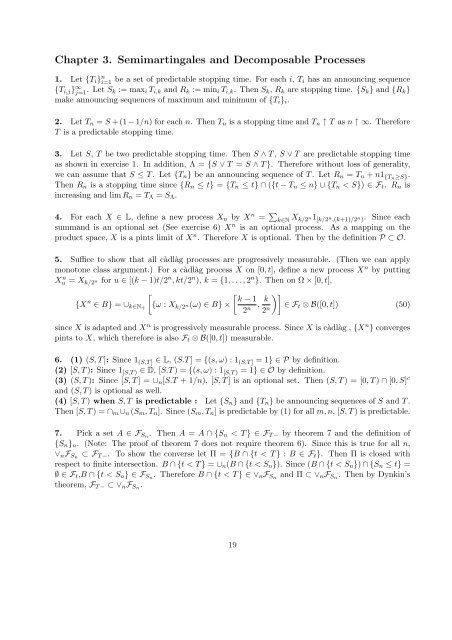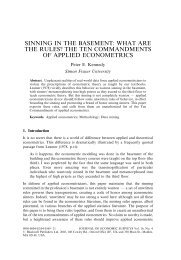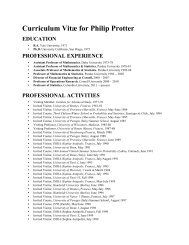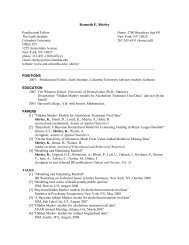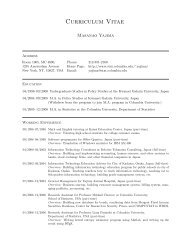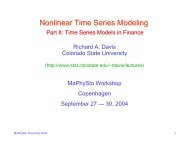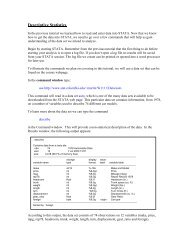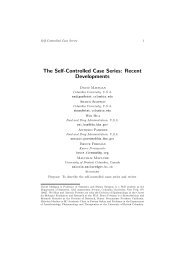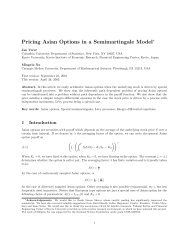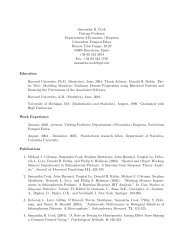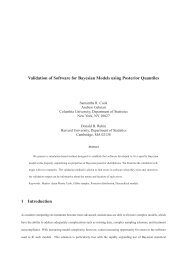Solution to selected problems.
Solution to selected problems.
Solution to selected problems.
You also want an ePaper? Increase the reach of your titles
YUMPU automatically turns print PDFs into web optimized ePapers that Google loves.
Chapter 3. Semimartingales and Decomposable Processes<br />
1. Let {T i } n i=1 be a set of predictable s<strong>to</strong>pping time. For each i, T i has an announcing sequence<br />
{T i,j } ∞ j=1 . Let S k := max i T i,k and R k := min i T i,k . Then S k , R k are s<strong>to</strong>pping time. {S k } and {R k }<br />
make announcing sequences of maximum and minimum of {T i } i .<br />
2. Let T n = S + (1 − 1/n) for each n. Then T n is a s<strong>to</strong>pping time and T n ↑ T as n ↑ ∞. Therefore<br />
T is a predictable s<strong>to</strong>pping time.<br />
3. Let S, T be two predictable s<strong>to</strong>pping time. Then S ∧ T , S ∨ T are predictable s<strong>to</strong>pping time<br />
as shown in exercise 1. In addition, Λ = {S ∨ T = S ∧ T }. Therefore without loss of generality,<br />
we can assume that S ≤ T . Let {T n } be an announcing sequence of T . Let R n = T n + n1 {Tn ≥S}.<br />
Then R n is a s<strong>to</strong>pping time since {R n ≤ t} = {T n ≤ t} ∩ ({t − T n ≤ n} ∪ {T n < S}) ∈ F t . R n is<br />
increasing and lim R n = T Λ = S Λ .<br />
4. For each X ∈ L, define a new process X n by X n = ∑ k∈N X k/2 n1 [k/2 n ,(k+1)/2 n ). Since each<br />
summand is an optional set (See exercise 6) X n is an optional process. As a mapping on the<br />
product space, X is a pints limit of X n . Therefore X is optional. Then by the definition P ⊂ O.<br />
5. Suffice <strong>to</strong> show that all càdlàg processes are progressively measurable. (Then we can apply<br />
mono<strong>to</strong>ne class argument.) For a càdlàg process X on [0, t], define a new process X n by putting<br />
Xu n = X k/2 n for u ∈ [(k − 1)t/2 n , kt/2 n ), k = {1, . . . , 2 n }. Then on Ω × [0, t],<br />
[ k − 1<br />
{X n ∈ B} = ∪ k∈N+<br />
[{ω : X k/2 n(ω) ∈ B} ×<br />
2 n , k )]<br />
2 n ∈ F t ⊗ B([0, t]) (50)<br />
since X is adapted and X n is progressively measurable process. Since X is càdlàg , {X n } converges<br />
pints <strong>to</strong> X, which therefore is also F t ⊗ B([0, t]) measurable.<br />
6. (1) (S, T ]: Since 1 (S,T ] ∈ L, (S.T ] = {(s, ω) : 1 (S,T ] = 1} ∈ P by definition.<br />
(2) [S, T ): Since 1 [S,T ) ∈ D, [S.T ) = {(s, ω) : 1 [S,T ) = 1} ∈ O by definition.<br />
(3) (S, T ): Since [S, T ] = ∪ n [S.T + 1/n), [S, T ] is an optional set. Then (S, T ) = [0, T ) ∩ [0, S] c<br />
and (S, T ) is optional as well.<br />
(4) [S, T ) when S, T is predictable : Let {S n } and {T n } be announcing sequences of S and T .<br />
Then [S, T ) = ∩ m ∪ n (S m , T n ]. Since (S m , T n ] is predictable by (1) for all m, n, [S, T ) is predictable.<br />
7. Pick a set A ∈ F Sn . Then A = A ∩ {S n < T } ∈ F T − by theorem 7 and the definition of<br />
{S n } n . (Note: The proof of theorem 7 does not require theorem 6). Since this is true for all n,<br />
∨ n F Sn ⊂ F T − . To show the converse let Π = {B ∩ {t < T } : B ∈ F t }. Then Π is closed with<br />
respect <strong>to</strong> finite intersection. B ∩ {t < T } = ∪ n (B ∩ {t < S n }). Since (B ∩ {t < S n }) ∩ {S n ≤ t} =<br />
∅ ∈ F t ,B ∩ {t < S n } ∈ F Sn . Therefore B ∩ {t < T } ∈ ∨ n F Sn and Π ⊂ ∨ n F Sn . Then by Dynkin’s<br />
theorem, F T − ⊂ ∨ n F Sn .<br />
19


